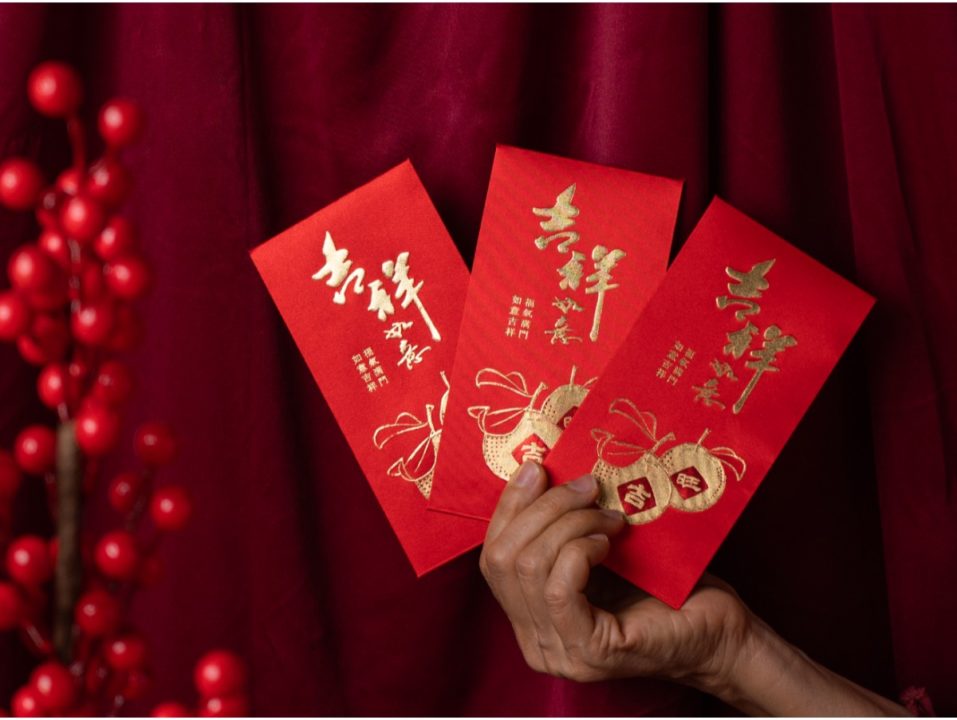Will you be giving out red envelopes this Chinese New Year? The packets containing cash, called lai see (利是 or 利事) in Cantonese and hong bao (紅包) in Mandarin, are a traditional gift exchanged during celebration of the Lunar New Year. The monetary amount is not as important as what the envelope symbolizes, which is a wish for luck for the recipient.
With the festival fast approaching on February 10, 2024, if you want to get involved but are not sure of the etiquette, here’s everything you need to know. The most basic things to remember are to give and receive lai see with two hands and wish everyone the essential Lunar New Year greeting, “Gong hey fat choy,” roughly meaning “Best wishes for prosperity in the new year.”
What is the history of lai see?
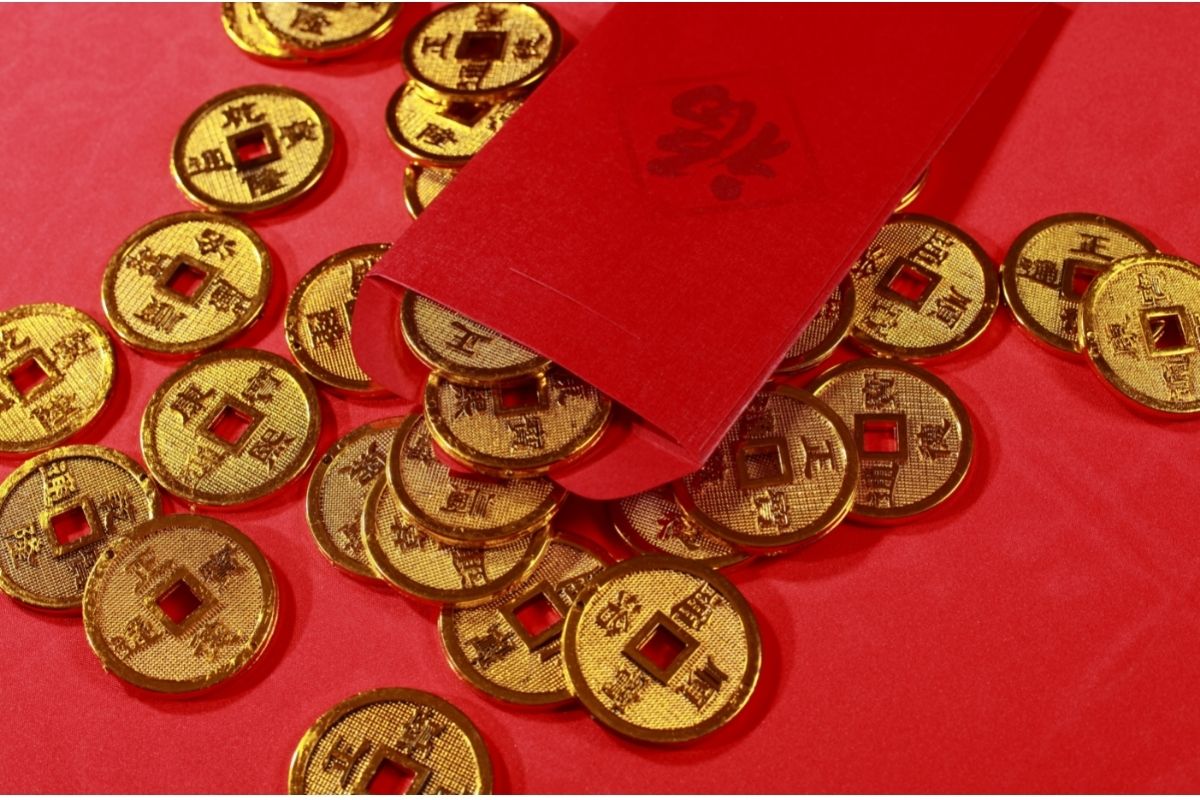
How did the tradition of giving lai see start? According to Chinese folklore, an evil spirit named “Sui’‘ (祟) was roaming around during New Year’s Eve. This demon attacked everyone who was sleeping. So everybody started staying awake to wait for the New Year, keeping all lights on and saying, “Shou Sui” (守祟).
On one New Year’s Eve past, a couple gave their son pockets of coins to play with to help him stay awake. The son wrapped the coins in red paper, unwrapped them, and wrapped them again until he got tired and eventually slept. His parents then decided to place the wrapped coins under his pillows. Sui the devil came and was about to attack the son, when the coins shined so bright that they warded off Sui.
Since then, the belief has come about that the colour of red wards off evil spirits, hence the giving of lai see. Before, coins stringed together (old coins had holes in the middles) and wrapped in red paper were given to children. But as generations passed, the coins became bills slipped into red packets.
What’s the symbolism of giving red envelopes?
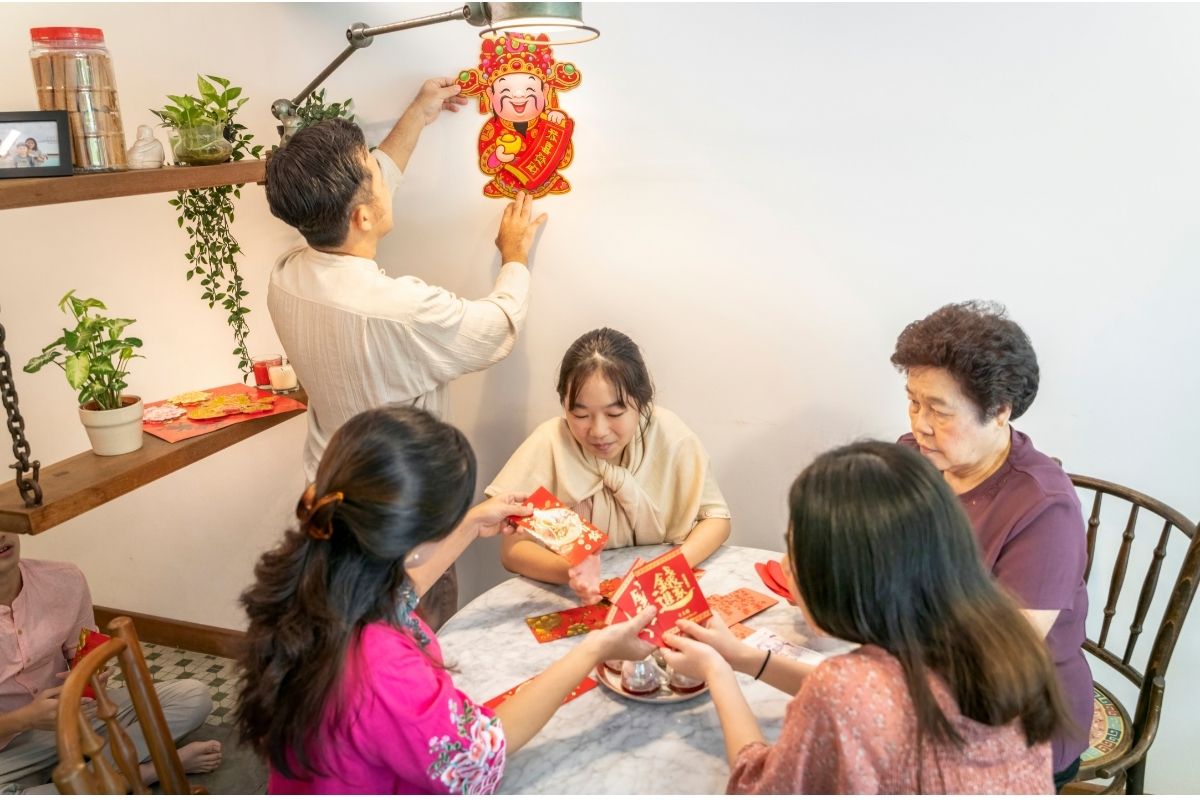
Several Chinese traditions include the giving of a lai see. At a wedding ceremony, lai see is gifted to the bride and groom with the belief that it will give them fortune. During Chinese New Year, families distribute lai see to the younger family members. And as generations have passed, the tradition has extended to almost all festive social gatherings in China and other Asian cultures.
The money inside is not the focus, though. The most important element is the red envelope that wraps the money. Red is a significant color in Chinese culture; it is believed to bring energy, fortune, and happiness. If you receive a lai see, it means someone wishes you to have a good life ahead.
Who should give red packets?
By giving lai see you are wishing prosperity and good luck for the coming year, so consider who you want to thank and wish well. A good guide for who should give lai see is going from big to small, senior to junior. Definitely don’t let your kids give out lai see to older people, as this can be considered rude. While people from many countries practice this tradition and there is variance in etiquette, there are some general important points to keep in mind. It is critical to follow these so as not to eliminate the true essence of lai see giving.
Parents to children
Giving starts within the family. Parents leave a lai see and two tangerines with fresh leaves at their children’s bedside on New Year’s Eve. The amount inside is usually HK$20 and up, an amount large enough for them to buy a new toy. And during New Year’s Day, as children visit their elders, grandparents give them lai see, too. Until kids get older and start amassing their own wealth, they continue getting lai see from their elder family members.
Married to unmarried family members
On New Year’s Day, married members of the family give lai see of HK$50 to HK$100 to the unmarried younger ones (up to age 25). The married members are believed to have collected enough fortune to share with others, especially with the family. In their first year of marriage, married couples give one pocket each (e.g. one pocket from the husband and one from the wife). In subsequent years, they give one pocket together as a couple.
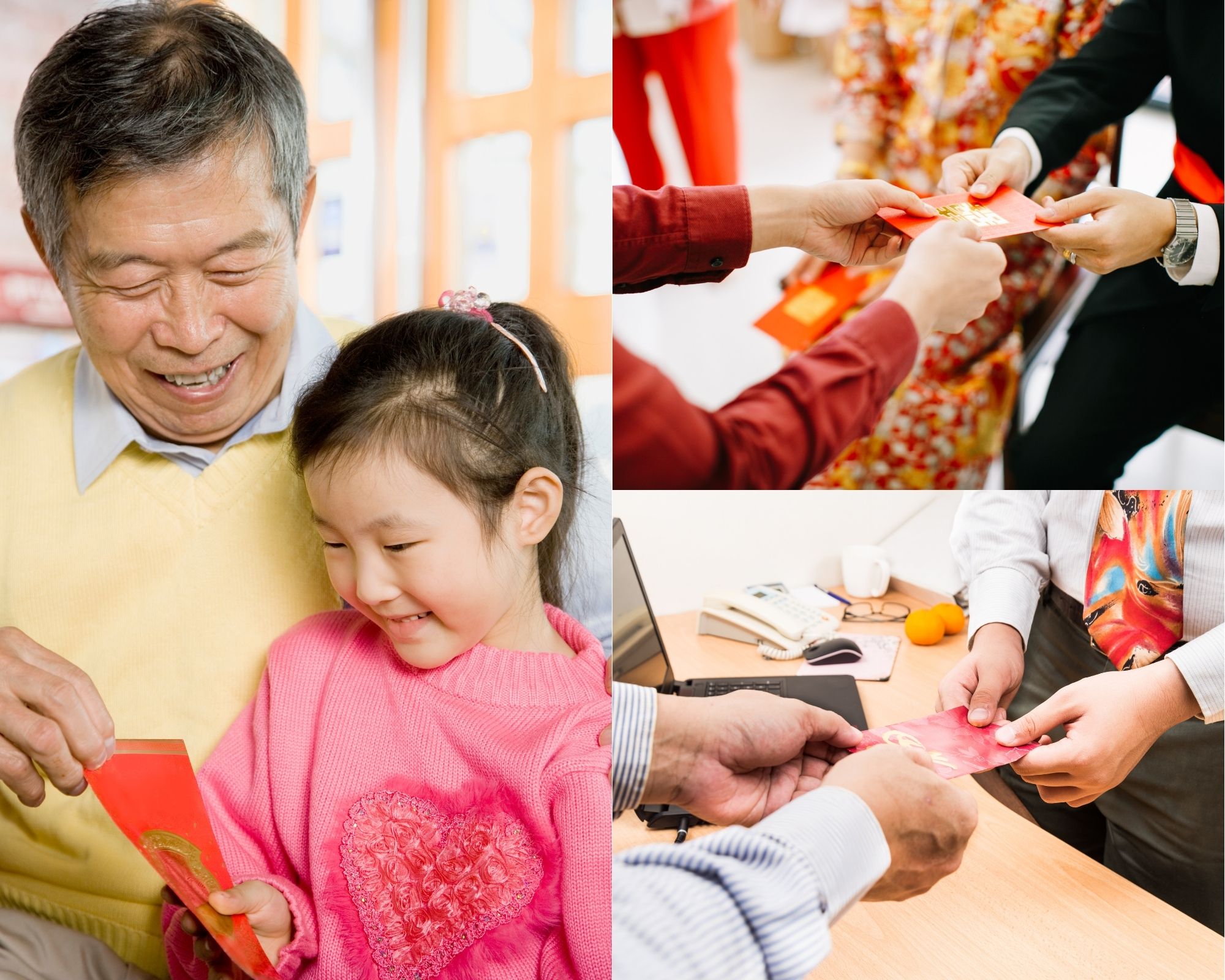
Children to parents/young to elderly family members
To reciprocate the love, care, blessings, and gifts given by their parents, adult children give lai see to their parents. Married family members also give elderly members lai see. This is their way of paying respect to their elders. The amount inside is usually large (HK$50 to HK$100 at least). Often, parents reciprocate by giving back a lai see double this amount.
Elders to extended family members
Celebrating the Lunar New Year occurs over multiple days. For days after New Year’s Day, families pay respect to extended relatives. Thus, giving red envelopes (around HK$20) is extended too. Younger people can visit older relatives’ homes or older relatives can visit their home. To add fun, a tray of sweets is presented to children with the lai see on the tray.
Senior to junior staff
A person with authority is also to give red packets to the people they manage. In return, fortune and right turns will be experienced by their business all year round.
How to give and receive lai see?
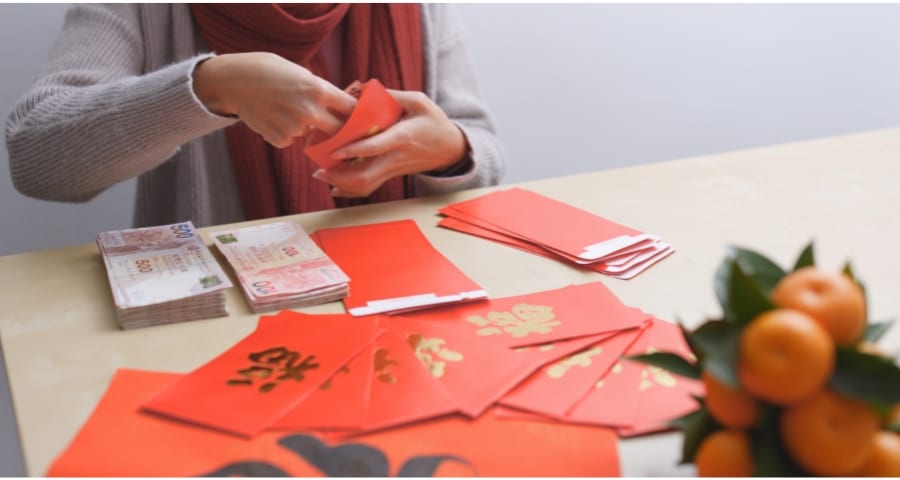
Giving lai see is not done at random. Here is a list of best practices to follow, so you can make the most out of the giving and receiving. Following these they will allow you to reap the full benefits of the tradition:
- Money inside should not total to an odd number because odd numbers are related to funerals. The number nine is an exception because nine denotes a long life.
- The number four should also be avoided because its pronunciation is the same as the word for ‘death’. So, one should not give the amounts of HK$40, HK$400, HK$444, or HK$4,000.
- When given at weddings, the amount inside should be significant enough to help cover the wedding expenses of the couple and to help them with their future living (starting from HK$500).
- Prepare the lai see in advance and prepare more than enough for the fifteen days of Chinese New Year celebration. This way, you can instantly give it to someone you bump into.
- You should give someone the lai see the first time you see them during the new year period.
- During the new year season, the giving should only be within the fifteen days of Chinese New Year celebration (from New Year’s Eve to Lantern Festival), not before or after.
- Give and receive lai see with both hands; it is impolite if you do it with one hand only.
- Do not attempt to open the envelope in front of the giver; this is also impolite.
- Lai see is also not given as a tip or a payment. Never use the lai see on the wrong occasion.
- Children should never be allowed to give lai see.
- There should only be a single bill in one envelope. You can give multiple envelopes with one bill in each.
- Use crisp bills. You can exchange old or crumpled bills at banks if you don’t have new bills.
- To be more organized, use different envelopes for different groups of people (e.g. family, friends, and strangers). Or you can use separate envelopes for different amounts of money, so you won’t have a hard time identifying which one to give someone.
- Children should kneel when they receive their lai see as a sign of respect. (However, this practice is becoming less common.)
What to say when giving and receiving lai see?
These phrases can be said both ways, by the giver and the receiver. Usually, older people will specifically wish younger people luck in their work or studies, whichever they are currently doing; younger people will usually wish their elders good health for a long life.
- “Sun nin fai lok!” (新年快樂), meaning “Happy New Year!”
- “Gong hei fat choy!” (恭喜發財), meaning congratulations and wishing you prosperity.
- “Sun tai gin hong!” (身體健康), meaning a wish for good health.
- “Gung ho sun hei” (賀新禧), a more formal phrase for “Happy New Year.”
- “Dai gat dai lei” (大吉大利), meaning a wish for good luck.
- And the most important is “Doh jeh” (多謝), a formal “Thank you.”
For a full how-to to what to say to wish another luck and a wealth of other blessings during the new year, check out our guide to Chinese New Year greetings.
How much to give in red packets?
Cleaners, security guards, receptionists, and concierges at your building will all be hoping to receive something from you. Any services that you regularly use, like your hairdresser or the staff at your local café, would welcome an envelope too. At your workplace, you should plan to give to junior staff in your team as well as your security guards, receptionists and cleaners. Here’s a general guide on how much to give:
| Recipient | Amount |
| Family | HK$50-HK$100 or more depending on what you feel comfortable with, how close you are, and the family member’s age |
| Visitors during CNY who bring a gift | HK$50-HK$100 |
| Single friends | HK$20 or HK$50 depending on how close you are |
| Children outside your family | HK$10-HK$20 |
| Guard/doorman/cleaning staff/maintenance staff at your building | HK$20-HK$50 |
| Helper/driver | HK$100 |
| Colleagues | HK$20 |
| Senior staff to subordinates | HK$50-HK$100 |
| Waiters/baristas | HK$20 |
| Hairdresser/manicurist/therapist | HK$50-HK$100 |
Giving of lai see this is not a random act. There are reasons why Chinese people (and other Asian cultures) give these red envelopes. Keep in mind that the essence of the tradition is not the amount of money you can collect. The true essence is building and rekindling relationships, paying respect, and wishing fortune and good luck.
Header image credits: studiosea via Canva


